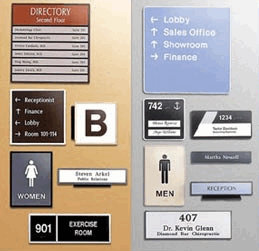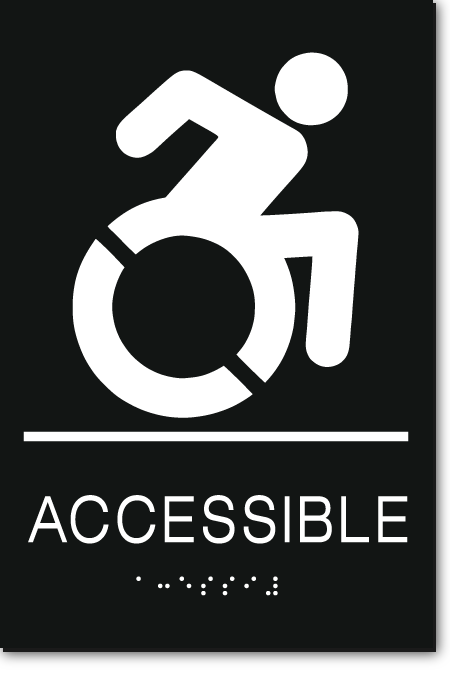How ADA Signs Improve Access for Everyone
ADA Signage: Ensuring Accessibility and Conformity in Public Spaces
ADA signage plays a vital duty in guaranteeing access and compliance within public rooms, considerably contributing to a comprehensive atmosphere for people with disabilities. By adhering to ADA criteria, signage not just promotes navigation however additionally underscores a company's devotion to variety and equality. As we check out the subtleties of ADA signs, from tactile functions to create complexities, it's critical to consider exactly how these components integrate to copyright the legal rights of all users. What are the typical challenges companies deal with in keeping compliance, and exactly how can future fads in signs proceed to drive ease of access ahead?
Value of ADA Signage
In contemporary society, the significance of ADA signage expands past plain conformity with legal mandates to personify a dedication to inclusivity and access for all people. These indications are vital in producing environments where people with handicaps can browse public areas with the same convenience and freedom as those without specials needs. By offering clear and standardized info, ADA signage ensures that every person can access centers, services, and details without obstacles.
The significance of ADA signage depends on its capacity to improve the high quality of life for people with disabilities by advertising equal accessibility. It gets rid of the obstacles that could otherwise prevent their capability to take part fully in area life. Additionally, these signs function as visible indicators of a company's commitment to variety and equal rights, reflecting more comprehensive societal values that promote the rights and self-respect of all individuals.
In addition, ADA signage plays a crucial function in public safety and security. By directing people to exits, washrooms, and various other important centers, it makes certain that all people, despite physical ability, can evacuate securely throughout emergencies. In summary, ADA signs is not simply a regulative need yet a powerful tool for cultivating a comprehensive and equitable culture.
Key Aspects of Conformity

Placement is important; indications have to be mounted in areas that are easily visible and obtainable. Commonly, signs needs to be installed between 48 and 60 inches from the ground to make sure accessibility for both standing and mobility device users. Tactile components, such as Braille, are essential for people with aesthetic disabilities, providing critical details in a non-visual layout.
High-contrast shades between the message and history are needed to enhance readability for people with reduced vision. The ADA mandates particular contrast proportions to make sure clearness. Additionally, personality size is a key factor to consider, with minimal height requirements determined by the viewing range to guarantee readability from different angles.
Design Factors To Consider for Access
Creating accessible signs needs a meticulous strategy to guarantee it satisfies the needs of all individuals, particularly those with impairments. The size of the message is equally important, with ADA standards advising a minimum elevation based on seeing distance to make certain legibility.
Contrasting colors between text and history are essential for presence, especially for individuals with aesthetic disabilities. Furthermore, tactile components, such as Braille and increased personalities, are vital for individuals who are blind or have reduced vision.
Moreover, the positioning of signs plays a substantial role in availability. Indications ought to be set up in locations that are easily obtainable and unobstructed. Ensuring that signs is mounted at suitable elevations and angles makes it possible for all customers, including those using mobility devices, to connect with them efficiently.
Common Blunders to Avoid

Another prevalent mistake is the wrong positioning of signage. ADA guidelines specify precise elevation and location demands to make sure that indications are easily visible and obtainable by all individuals, consisting of those using wheelchairs. Overlooking these guidelines not only hinders availability yet likewise takes the chance of non-compliance with legal standards.
In addition, not enough comparison between message and background is a frequent oversight. Appropriate contrast is essential for readability, specifically for individuals with reduced vision. Designers often choose colors that are aesthetically appealing yet do not have the essential comparison, rendering the message hard to determine.
Last but not least, some designers stop working to include responsive aspects, such as Braille, which are vital for individuals who are blind. Omitting these attributes not just leads to non-compliance with ADA policies yet likewise limits gain access to for a sector of the populace that relies upon tactile details.
Future Trends in Signs
Improvements in innovation and raising recognition of inclusivity are shaping the future see this here fads in signs design. As society becomes a lot more mindful of diverse requirements, the combination of smart innovations into signs is acquiring grip. Digital signage, for example, is advancing to include real-time updates and interactive attributes, which can be essential in providing dynamic information in public spaces. These indications commonly incorporate touch screens or gesture-based controls, allowing users to browse content tailored to their particular requirements.
An additional arising fad is the usage of augmented truth (AR) to improve user experience. AR-enabled signs can overlay electronic details onto the physical setting, supplying visually damaged individuals with auditory or haptic responses. ADA Signs. This technology not only improves access yet additionally develops an appealing visit their website experience for all customers
Sustainability is likewise a significant aspect influencing signage patterns. Environmentally friendly products and energy-efficient lighting services are being focused on to align with international environmental goals. Innovations in materials science are leading to the advancement of even more weather-resistant and resilient indications.
Verdict
ADA signage plays an essential function in assuring access and conformity within public areas by integrating responsive elements, high-contrast shades, and critical positioning. The adherence to ADA requirements not only promotes risk-free navigating for people with handicaps but also indicates an organization's commitment to diversity and inclusivity. By avoiding common mistakes and embracing future fads, public rooms can remain to progress these values, guaranteeing that the civil liberties and dignity of all people are appreciated and promoted.
ADA signage plays an important function in assuring ease of access and compliance within public spaces, substantially contributing to an inclusive atmosphere for people with disabilities. As we check out the subtleties of ADA signage, from tactile functions to make ins and outs, it's critical to think about how these aspects integrate to support the rights of all individuals.In modern society, the significance of ADA signs prolongs past mere conformity with legal mandates to personify a dedication to inclusivity and availability for all people. By giving clear and standard info, ADA signage makes certain that everybody can access facilities, services, and information without obstacles.
ADA signs plays an essential role in assuring ease of access and compliance within public areas by integrating tactile components, high-contrast shades, and this post critical placement. (ADA Signs)